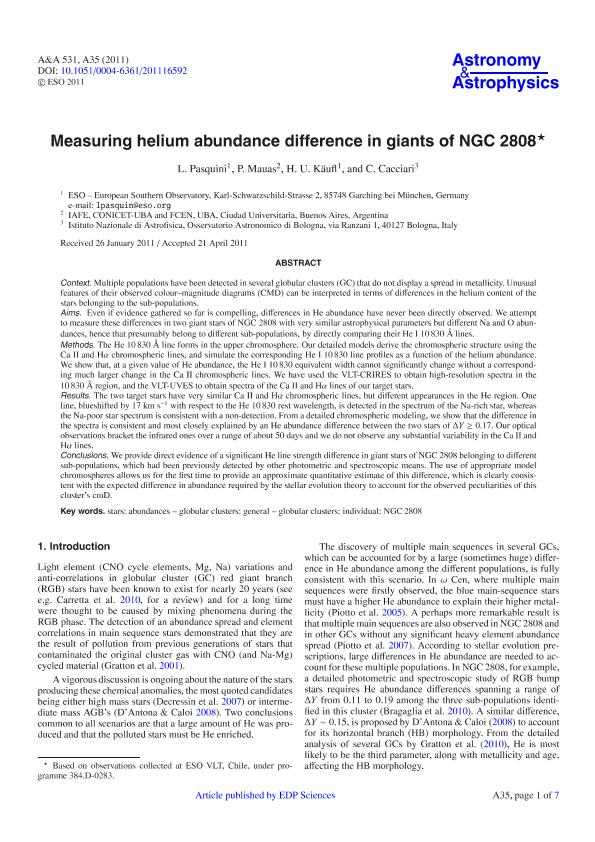Mostrar el registro sencillo del ítem
dc.contributor.author
Pasquini, L.
dc.contributor.author
Mauas, Pablo Jacobo David

dc.contributor.author
Käufl, H. U.
dc.contributor.author
Cacciari, Carla
dc.date.available
2017-07-07T19:46:37Z
dc.date.issued
2011-07
dc.identifier.citation
Pasquini, L.; Mauas, Pablo Jacobo David; Käufl, H. U.; Cacciari, Carla; Measuring helium abundance difference in giants of NGC 2808; EDP Sciences; Astronomy and Astrophysics; 531; 7-2011; A35,1-7
dc.identifier.issn
0004-6361
dc.identifier.uri
http://hdl.handle.net/11336/19885
dc.description.abstract
Context. Multiple populations have been detected in several globular clusters (GC) that do not display a spread in metallicity. Unusual features of their observed colour–magnitude diagrams (CMD) can be interpreted in terms of differences in the helium content of the stars belonging to the sub-populations. Aims. Even if evidence gathered so far is compelling, differences in He abundance have never been directly observed. We attempt to measure these differences in two giant stars of NGC 2808 with very similar astrophysical parameters but different Na and O abundances, hence that presumably belong to different sub-populations, by directly comparing their He I 10 830 Å lines. Methods. The He 10 830 Å line forms in the upper chromosphere. Our detailed models derive the chromospheric structure using the Ca II and Hα chromospheric lines, and simulate the corresponding He I 10 830 line profiles as a function of the helium abundance. We show that, at a given value of He abundance, the He I 10 830 equivalent width cannot significantly change without a corresponding much larger change in the Ca II chromospheric lines. We have used the VLT-CRIRES to obtain high-resolution spectra in the 10 830 Å region, and the VLT-UVES to obtain spectra of the Ca II and Hα lines of our target stars. Results. The two target stars have very similar Ca II and Hα chromospheric lines, but different appearances in the He region. One line, blueshifted by 17 km s-1 with respect to the He 10 830 rest wavelength, is detected in the spectrum of the Na-rich star, whereas the Na-poor star spectrum is consistent with a non-detection. From a detailed chromospheric modeling, we show that the difference in the spectra is consistent and most closely explained by an He abundance difference between the two stars of ΔY ≥ 0.17. Our optical observations bracket the infrared ones over a range of about 50 days and we do not observe any substantial variability in the Ca II and Hα lines. Conclusions. We provide direct evidence of a significant He line strength difference in giant stars of NGC 2808 belonging to different sub-populations, which had been previously detected by other photometric and spectroscopic means. The use of appropriate model chromospheres allows us for the first time to provide an approximate quantitative estimate of this difference, which is clearly consistent with the expected difference in abundance required by the stellar evolution theory to account for the observed peculiarities of this cluster’s cmD.
dc.format
application/pdf
dc.language.iso
eng
dc.publisher
EDP Sciences

dc.rights
info:eu-repo/semantics/openAccess
dc.rights.uri
https://creativecommons.org/licenses/by-nc-sa/2.5/ar/
dc.subject
Stars: Abundances
dc.subject
Globular Clusters: General
dc.subject
Globular Clusters: Individual: Ngc 2808
dc.subject.classification
Astronomía

dc.subject.classification
Ciencias Físicas

dc.subject.classification
CIENCIAS NATURALES Y EXACTAS

dc.title
Measuring helium abundance difference in giants of NGC 2808
dc.type
info:eu-repo/semantics/article
dc.type
info:ar-repo/semantics/artículo
dc.type
info:eu-repo/semantics/publishedVersion
dc.date.updated
2017-07-07T15:19:14Z
dc.journal.volume
531
dc.journal.pagination
A35,1-7
dc.journal.pais
Francia

dc.journal.ciudad
Paris
dc.description.fil
Fil: Pasquini, L.. European Southern Observatory; Alemania
dc.description.fil
Fil: Mauas, Pablo Jacobo David. Consejo Nacional de Investigaciónes Científicas y Técnicas. Oficina de Coordinación Administrativa Ciudad Universitaria. Instituto de Astronomía y Física del Espacio. - Universidad de Buenos Aires. Facultad de Ciencias Exactas y Naturales. Instituto de Astronomía y Física del Espacio; Argentina
dc.description.fil
Fil: Käufl, H. U.. European Southern Observatory; Alemania
dc.description.fil
Fil: Cacciari, C.. Osservatorio Astronomico di Bologna; Italia
dc.journal.title
Astronomy and Astrophysics

dc.relation.alternativeid
info:eu-repo/semantics/altIdentifier/doi/http://dx.doi.org/10.1051/0004-6361/201116592
dc.relation.alternativeid
info:eu-repo/semantics/altIdentifier/url/https://arxiv.org/abs/1105.0346
dc.relation.alternativeid
info:eu-repo/semantics/altIdentifier/url/https://www.aanda.org/articles/aa/abs/2011/07/aa16592-11/aa16592-11.html
Archivos asociados
